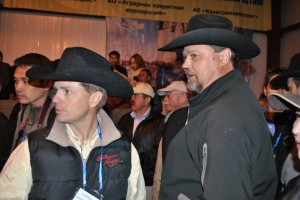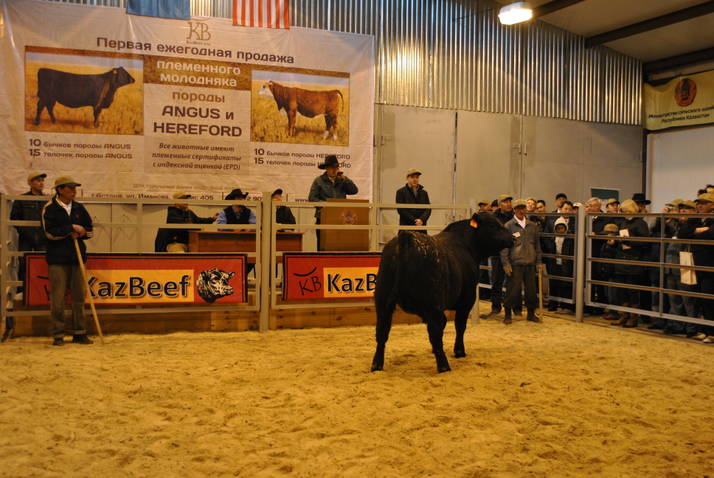Kazakhstan’s American-flavored first cattle auction a success
(Hal Foster appears in the Baltimore Post-Examiner under a partnership with Tengrinews of Kazakhstan. )
It was one of the biggest days of Beibit Yerubayez’s life, and he was worried.
The weather wasn’t cooperating. It was a few degrees above zero, and raining. In fact, it was raining sideways, the drops pushed along by a howling wind.
Beibit, the Astana-based head of the Kazakhstan government’s KazBeef operation, was afraid that many of those he’d invited to the day’s important event near the village of Mamai, three hours north of Astana, would take one look at the weather and go back to bed.
But Kazakhstan cattle ranchers are as hardy as their American counterparts. Besides, they knew this event would be historic: Kazakhstan’s first-ever cattle auction. There was no way they’d miss it.
I was one of almost 200 people who showed up for the recent auction at the 132,000-hectare – or 330,000-acre — KazBeef ranch at Mamai. About 50 were cattle buyers. Others included government officials, American ranchers connected with the KazBeef operation, journalists, Nazarbayev University professors and cowhands.
Many of the buyers, the auctioneer and the Americans dressed for the occasion with cowboy hats, although some looked suspiciously like Australian models rather than American.
It was so cold and damp that even in the huge metal Quonset hut that housed the auction ring, my hands became red and then blue.
Mike Slattery, the 24-year-old cowboy who runs the ranch, welcomed the crowd, as did U.S. Ambassador Kenneth Fairfax, Deputy Agriculture Minister Muslim Umiryaev and the chairman of the government’s KazAgro national holding company, Berik Beysengaliev.

He told the assemblage that KazBeef’s goal is to produce a cow “that will survive the climate, raise a big calf and rebreed every year with little input costs.”
He said the company will focus on building the kind of trust that leads to it seeing “the same customers year after year” – a pledge that drew applause.
The ambassador said the auction was a symbol of a Kazakhstan-American success story. The two countries’ beef-industry cooperation also is a “people story.” The friendships that are forming between the Kazakhs and Americans involved in the effort “will last a lifetime,” he said.
When the bidding for the 50 purebred Angus and Herefords started, most of the crowd forgot the cold for awhile.
Not only were the cattle the first to be auctioned in Kazakhstan, but they were also the first purebred Angus and Herefords born and raised in the country.
KazBeef imported hundreds of pregnant heifers from the United States over 18 months as part of the government’s decision to turn Kazakhstan into one of the world’s biggest beef producers. The hundreds of imports and their locally born offspring have quickly swelled the Mamai herd to 4,000.
A big black Angus bull was the first to go on the auction block. The bidding was spirited, with the final price 875,000 tenge, or a shade under $6,000.
The KazBeef crowd breathed a sigh of relief. Going into the auction, they’d had no idea what the cattle would bring. Six thousand dollars was a good price.
In fact, it was about 20 percent more than what the bull would have fetched at an American auction. The reason is that these cattle are the vanguard of Kazakhstan’s Angus and Hereford herds.
Under the law of supply and demand, their relative scarcity helped them command a premium price this day. Prices will likely drop as Kazakhstan’s herds increase, the Americans at the auction said.
The American contingent included brothers Dan and Bill Price and their business associate Chad Ellingson of Mandan, North Dakota; Barry Wentz of Napoleon, North Dakota; and Quinn Engel of Bentonville, Arkansas.
The five are playing key roles in the KazBeef operation.

Dan and Bill Price, who own Global Beef Consultants in their home state, have a 15 percent stake in KazBeef. The brothers have rounded up hundreds of cattle from across the American Midwest the past three years to start Kazakhstan’s Angus and Hereford herds.
Chad Ellingson, who also owns a North Dakota ranch, has played a big part in obtaining semen for the artificial insemination of the Kazakhstan-bound heifers – much of it from his own bulls.
“The way I look at it, a lot of our ancestors came from Russia (and Russia’s neighbors such as Kazakhstan),” Dan Price said of the Old World’s contribution to building American agriculture. The story’s come full circle, he said. “Now we’re here pioneering.”
The first shipment of 170 American purebreds arrived in Astana in October 2010 on a Boeing 747. Dan and Bill were the ones who asked Mike, who is from Indianola, Nebraska, to run the Mamai ranch. Mike flew in with the first load of cattle on a snowy, sleety day.
The animals’ arrival was a big deal, generating world headlines. Even The New York Times did a story.
The Prices, who own North Dakota’s biggest feedlot – or cattle-fattening – operation, have enlisted Barry Wentz for another important KazBeef project: growing forage crops.
Cattle in Kazakhstan do well on grass, but to maintain their weight in winter, when their energy requirements are higher, they need forage.
A lot of American states use corn for forage, but corn requires a long growing season, and Kazakhstan’s seven-month winters mean its growing season is short.
Some Kazakhstan farmers tried raising corn last year, “but the crop was poor,” said Barry, who in addition to being a forage expert owns the North Dakota agricultural-equipment company CrossWater Enterprises.
So Wentz is looking at growing crops such as peas, barley and sorghum in Kazakhstan instead of corn.
Forage production will begin in the spring of 2013 with the planting of 10,000 to 15,000 hectares, Wentz said. Eventually there will be 25,000 hectares.
He has sold agricultural equipment to KazGrain, which, like KazBeef, is a subsidiary of Kazakhstan’s national agricultural holding company KazAgro. The forage-production program he is spearheading is a joint effort between KazBeef and KazGrain.
Quinn Engel is working on the formidable tasks of setting up slaughtering, meat-packing and marketing operations for KazBeef.
Kazakhstan needs tens of millions of dollars worth of modern slaughtering and meat-packing infrastructure. The facilities that Quinn helps KazBeef establish will point the way.
Most of Quinn’s career has been in marketing at the giant Tyson Foods corporation. That expertise will help him create a sales and promotion structure crucial to KazBeef’s success.
Kazakhstan’s cattle industry has huge potential. The domestic market consists of only 17 million people, but Russia and China, both of which border Kazakhstan, have a combined 1.5 billion. And Europe and the Middle East aren’t that far away.
When the auction was over, Beibit said, KazBeef had sold 45 of the 50 cattle put up for bid.
Slattery had decided not to sell five heifers because the bids were lower than he believed the cows were worth.
“The prices (on the animals that were sold) were very good,” Beibit enthused.
The highest price – for a bull – was 1.3 million tenge, or $8,700. Bulls typically bring higher prices than heifers.
The lowest price was 520,000 tenge, or $3,500, and the average was 670,000 tenge, or $4,500.
“For the first sale, we couldn’t have asked for more,” Beibit said. “It was beyond what I was expecting.
“We’ve gone from bringing the cattle here, to breeding them, calving and then selling them,” he said. “The next steps are to improve our technology in slaughtering, packaging and marketing.”
For information check out the following:

Hal Foster is a longtime journalist and journalism professor who has worked in the United States, Japan, Ukraine and Kazakhstan. His news career has included writing and editing at the Los Angeles Times and nine years as a journalist in Japan. He is an associate professor of Communication at the new Nazarbayev University in Astana, Kazakhstan. Catch one of his other blogs at en.tengrinews.kz.


Gentle readers,
I was checking my story about the Kazakhstan cattle auction in the Post-Examiner, and noticed that right below the headline was a photo of a big Angus cow and immediately below the photo was the line: (Hal Foster appears in the Baltimore Post-Examiner under a partnership with Tengrinews of Kazakhstan. )
To avoid confusion, I wanted to assure all readers that the cow in this photo does not bear the name Hal Foster.
If I were going to have my photo taken, I assure you it would NOT be with my backside to the camera. : )
HF